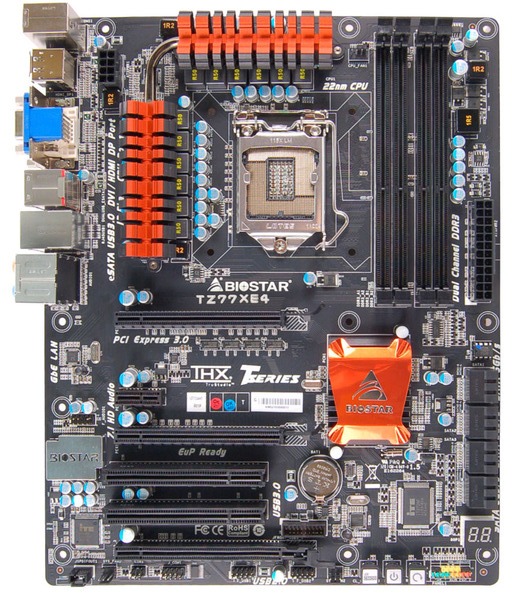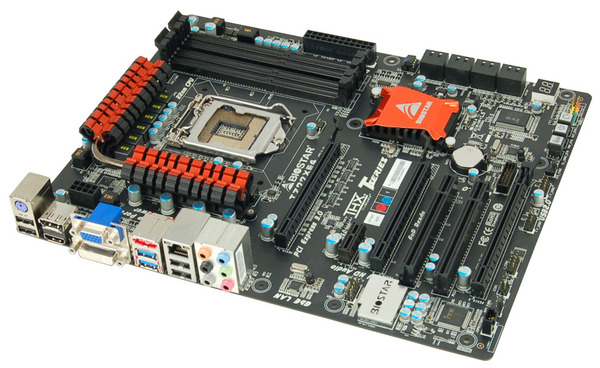Intel Z77 Panther Point Chipset and Motherboard Preview – ASRock, ASUS, Gigabyte, MSI, ECS and Biostar
by Ian Cutress on April 8, 2012 12:00 AM EST- Posted in
- Motherboards
- Intel
- Biostar
- MSI
- Gigabyte
- ASRock
- Asus
- Ivy Bridge
- ECS
- Z77
Biostar TZ77XE4—Visual Inspection
With memories of Biostar fresh in my mind from the 990FX roundup, I have another chance to tackle a motherboard from them. This one comes in at more of a premium than the other—at an MSRP of $169 it is not the cheapest board this time. However, it does seem to have learned some lessons with the PCIe layout at least, but in terms of features we are perhaps a bit lacking.
Biostar have characteristically been black and orange, and we see it here again on their top Z77 model, the TZ77XE4. Power delivery is essentially a 10+2 (CPU/iGPU) system with large brightly colored heatsinks to remove heat, both connected via a heatpipe. These heatsinks are set a little away from the Intel designated socket area, though the memory banks are right up against the boundary—with only two sticks of memory in the board there will be enough room for most of the beefiest air coolers.
In terms of fan headers, Biostar have unfortunately put much effort in here, with only three to play with—a 4-pin CPU fan header to the top right of the socket, and two 3-pin at the south end of the board. Anyone requiring headers for fans will have to resort to providing their own fan control.

Along the right hand side, apart from the 24-pin power connector, we have a series of eight SATA ports—two SATA 6 Gbps from the PCH, four SATA 3 Gbps also from the PCH, and another two SATA 6 Gbps from an ASMedia controller. These are unfortunately not color coded, meaning users will have to double check every time that the SATA cable is going into the port as intended. Below these, we have a two-digit debug display for error reporting.
The chipset heatsink sports the bright orange Biostar color, but is rather small which could lead to it being warm to the touch. On the south side of the board, we are not exactly bursting with headers—aside from the fans, we have front panel headers, a pair of USB 2.0 headers, and power/reset/clear CMOS buttons. These buttons are all similar and next to each other, so I can just see myself accidentally pressing the wrong one from time to time. It is also important to note the location of a USB 3.0 header, just above the third full-length PCIe slot. This is a rather awkward place, and cements its use primarily for rear facing adaptors (as long as there is nothing in the PCI slot beside it).

The PCIe layout is better than previous iterations, featuring an x16 (x8 in dual-GPU), x1, x8, PCI, PCI and Gen 2.0 x4. This leaves a space between GPUs, and a spare x1, PCI and x4 when dual GPUs are being used. Note we do not have a molex connector here, suggesting that Biostar are happy with the power delivery when the PCIe slots are in use.

For back panel functionality, we have a PS2 keyboard port, two USB 2.0 ports (black), DisplayPort, HDMI, D-Sub, DVI-I, eSATA, two USB 3.0 (blue), gigabit Ethernet, two more USB 2.0 (black), and audio jacks. I should stress that even though there is a DVI-I on the back panel, it does not accept analog signals by adaptor.
Board Features
| Biostar TZ77XE4 | |
| Size | ATX |
| CPU Interface | LGA-1155 |
| Chipset | Intel Z77 |
| Power Delivery | 10 + 2 + 1 + 2 (CPU/GPU/VCCIO/Memory) |
| Memory Slots |
Four DDR3 DIMM slots supporting up to 32 GB Up to Dual Channel, 1066-2600 MHz |
| Video Outputs | DisplayPort, HDMI, DVI-D, D-Sub |
| Onboard LAN | Realtek 8111E |
| Onboard Audio | Realtek ALC898 |
| Expansion Slots |
2 x PCIe x16 Gen3 (x16, x8/8) 1 x PCIe x16 Gen2 (x4) 1 x PCIe x1 Gen2 2 x PCI |
| Onboard SATA/RAID |
2 x SATA 6 Gbps (PCH), Support for RAID 0, 1, 5, 10 4 x SATA 3 Gbps (PCH), Support for RAID 0, 1, 5, 10 2 x SATA 6 Gbps (ASMedia Controller) 1 x eSATA 3 Gbps |
| USB |
4 USB 3.0 ports (2 back panel, 2 from headers) 8 USB 2.0 ports (4 back panel, 4 from headers) |
| Onboard |
4 x SATA 6 Gbps 4 x SATA 3 Gbps 1 x USB 3.0 Header 2 x USB 2.0 Header 3 x Fan Headers 1 x CIR Header 1 x SPDIF Output Header 1 x Front Panel Audio Header |
| Power Connectors |
1 x 24-pin ATX connector 1 x 8-pin 12V connector |
| Fan Headers |
1 x CPU Fan Header (4-pin) 2 x SYS Fan Header (3-pin) |
| IO Panel |
1 x PS/2 Keyboard Port 1 x eSATA 2 x USB 3.0 4 x USB 2.0 1 x DisplayPort 1 x HDMI 1 x DVI-D 1 x D-Sub 1 x Gigabit Ethernet Audio Jacks |
| Warranty Period | 3 years from date of sale |
| Product Page | Link |
Aside from the extra SATA controller, PCI slots, Power/Reset buttons and the use of all four display outputs, there's nothing much 'extra' that Biostar have put on the board which isn't already in the default chipset. This could perhaps be their downfall when it comes to conclusions after testing.










145 Comments
View All Comments
DanNeely - Monday, April 9, 2012 - link
This is similar to what happened with the USB1->2 transition. The newer controller is significantly bigger (read more expensive) and very few people have more than one or two devices using it per computer. I suspect the 8x (Haswell) chipset will be mixed as well; simply because the total number of ports on the chipset is so much higher than it was a decade ago (vs older boards were all but the lowest end models added more USB from 3rd party controllers).ASUSTechMKT - Monday, April 9, 2012 - link
mSATA currently has very little penetration on the market and cost wise it is much lower to purchase a larger cache SSD for the same or lower cost. We would prefer to focus on bringing implementations that offer immediate value to users.As for the Intel nics all our launch boards across the board for ATX ( Standard and above all feature Intel lan ) we have been leading in this regard for a couple of generations.
In regards to USB 3 we offer more than the standard on many boards but keep in mind many users only have 1 USB3 device.
jimnicoloff - Sunday, April 8, 2012 - link
Maybe I missed something from an earlier post, but could someone please tell me why these don't have light peak? Are they waiting to go optical and it is not ready yet? Having my USB3 controlled by Intel instead of another chip is not enough to make me want to upgrade my Z68 board...repoman27 - Sunday, April 8, 2012 - link
Thunderbolt controllers are relatively expensive ($20-30) and their value is fairly limited on a system using a full size ATX motherboard that has multiple PCIe slots. Including two digital display outputs, an x4 and a couple x1 PCIe slots on a motherboard provides essentially all the same functionality as Thunderbolt but at a way lower cost.ASUSTechMKT - Monday, April 9, 2012 - link
Almost all of our boards feature a special TB header which allows for you to easily equip our boards with a Thunderbolt add on card which we will release at the end of the month. Expect an approximate cost of $40 dollars, this card will connect to the TB header and install in a X4 slot providing you with Thunderbolt should you want it. A great option for those who want it and for those who do not they do not pay for it.DanNeely - Tuesday, April 10, 2012 - link
Sounds like a reasonable choice for something that's still rather expensive and a very niche product.Am I correct in thinking that the mobo header is to bring in the DisplayPort out channel without impacting bandwidth available for devices?
jimwatkins - Sunday, April 8, 2012 - link
I've made it this far on my venerable OC Q6600, but I can't wait any longer. I do wish they weren't so stingy on the 6 core as I could use it, but I just can't justify the price differential (w 3 kids that is.)androticus - Sunday, April 8, 2012 - link
USB 3.0 descriptions and depictions are contradictory. The platform summary table says there are 4. The Intel diagram shows up to 4 on front and back (and the diagram is itself very confusing, because there are 4 USB 3.0 ports indicated on the chipset, and then they show 2 going to hubs, and 2 going directly to the jacks.) The text of the article says there can only be 2 USB 3.0 ports.What is the correct answer?
mariush - Sunday, April 8, 2012 - link
I think there's 2 real ports (full bandwidth ports) and the Intel solution uses 2 additional chips that act like "hubs", splitting each real port into 4 separate ports.Basically the bandwidth of each real port gets split if there are several devices connected to the same hub.
Hub as far as I know means that what the hub receives sends to all four ports (and then the devices at the end of each port ignore the data if it's not for them).
This would be different than a switch, which has the brains to send the data packages only to the proper port.
plamengv - Sunday, April 8, 2012 - link
DZ77GA-70K makes DX79SI looks like a bad joke (which it is really).LGA 2011 turns into an epic fail and DZ77GA-70K is the proof. I have 1366 system and I have zero will to get LGA 2011 system thanks to the crappy tech decisions somebody made there. Six cores is the top? Again? An old 32nm process? Really? Chipset with nothing new inside but troubles? Since 1366 something strange is going on and Intel fails to see it. The end user can get better manufacturing tech for the video card than for the CPU. First it was 45nm CPU with 40nm GPU and now 28nm GPU and 32nm CPU and Intel call that high end? Really?
Everything that DX79SI should have been you can find inside DZ77GA-70K.
1. DZ77GA-70K has high quality TI 1394 firewire controller, while DX79SI has cheap VIA one that no any audio pro would ever want to deal with.
2. DZ77GA-70K has next best after Intel SATA controller by Marvell to get 2 more SATA 6.0 and eSATA vs zero extra SATA and hard to believe no any eSATA on DX79SI.
3. Intel USB 3.0 vs crappy Renesas.
DZ77GA-70K has everything to impress, including the two Intel LANs vs the Realtek that everyone else is using.
DZ77GA-70K fails in only one thing - it had to be LGA 2011, not 1155 that will be just 4 cores like forever and has zero future.
Wake up INTEL!